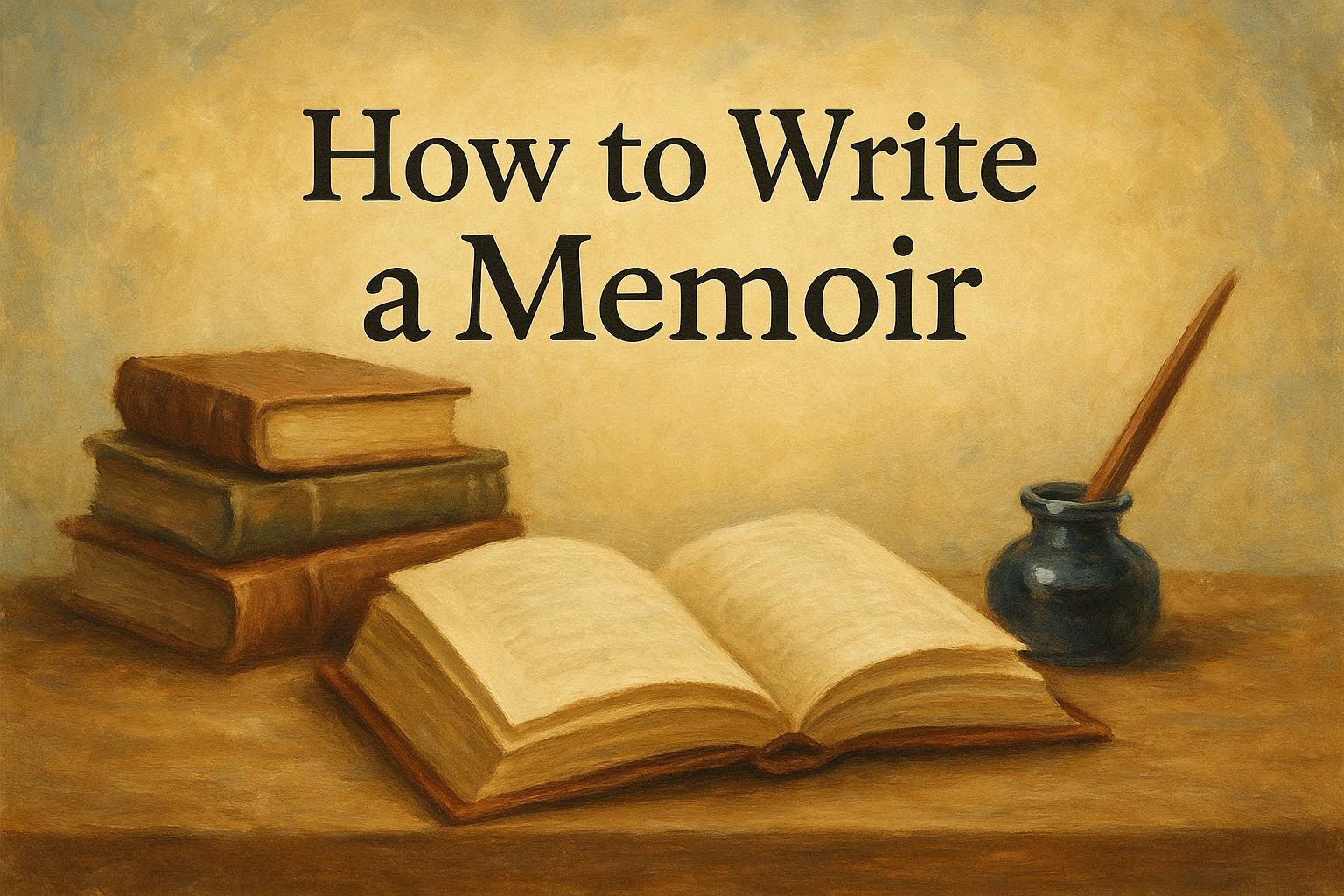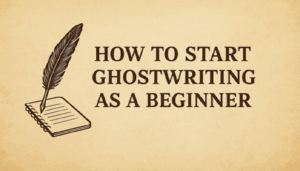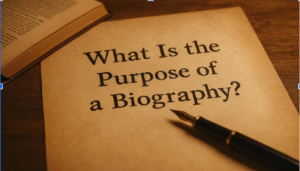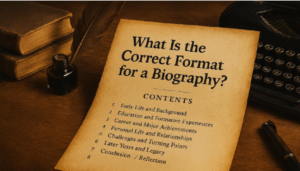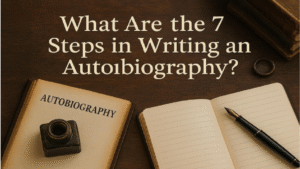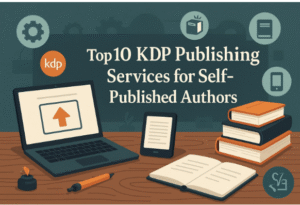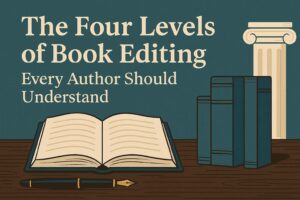Introduction
I once found an old journal buried in a box at the back of my closet. Pages torn, ink smudged, full of raw, unfiltered truth. I didn’t remember writing half of it, but I felt every word. That’s when it hit me: memory fades, but the feeling remains. And maybe that’s reason enough to write.
Memoir isn’t about listing what happened. It’s about making sense of it. It’s about choosing one thread from your life and following it, even if it takes you somewhere you didn’t expect.
Unlike autobiography, which aims to cover a whole life, a memoir focuses on a slice. A season. A question. A transformation. And in a world starved for connection, telling your true story matters more than ever.
In this guide, you’ll learn how to write a memoir with honesty, structure and heart. One scene. One memory. One truth at a time.
Why People Write Memoirs
Do you ever wonder why people feel a need to share their memories in a memoir? Exposing your memories for the whole world to see can’t be easy, yet sometimes that’s the only thing that could give us closure. Here are some big reasons why someone would feel like writing a memoir about their life.
To Make Sense of Your Story
Many people begin writing a memoir because they feel an urge to understand their past. Writing becomes a mirror. It helps you trace the path between who you were and who you’ve become. When you put your story on the page, details start to align and meanings begin to reveal themselves. You see things you couldn’t see when you were in the middle of living them.
To Preserve Family or Cultural History
Some stories belong to more than just you. Memoir can be a way to honor family, culture, or heritage. It keeps important memories from being lost to time. These are stories that shape identity and remind future generations where they came from. Writing them down is a way of saying, this mattered.
To Heal and Process
Memoir is often written from pain. Whether it’s trauma, grief, addiction, or loss, putting it into words can be transformative. Writing doesn’t erase the hard parts, but it gives them a shape. It helps you take back control. For many, the page becomes a safe place to untangle what happened and begin to heal.
To Help and Inspire Others
Sometimes the story you write isn’t just for you. Maybe you’ve survived something that others are still walking through. Your words can be the bridge someone else needs. Memoir creates connection. It says, you’re not alone. It turns your experience into something generous.
To Build a Personal Brand or Platform
Memoir can also be a tool for building credibility and trust. Entrepreneurs, creatives, and thought leaders often use memoir to share their journey in a way that feels human and relatable. A well-told story can open doors and start conversations no pitch deck ever could.
Because the Story Won’t Let You Go
And then, there’s the quiet reason: because you want to. Because something inside you is asking to be written. That alone is reason enough.
Wherever you’re starting, remember that support exists. You’ll find plenty of memoir writing tips online and in books, that can help shape your ideas into something powerful and polished.
No matter your reason, reflection, healing, legacy or inspiration, your story is worth telling.
Memoir vs Autobiography: What’s the Difference?
What Is an Autobiography?
An autobiography is a chronological retelling of your entire life, from beginning to present day. It usually starts with your birth or early childhood and moves forward, hitting all the key moments along the way; school, relationships, career, milestones. It focuses on facts, events and timelines. The goal is often to document a full life, typically for historical, public or legacy purposes.
You’ll often find autobiographies written by public figures, celebrities or people with high-profile careers who want to preserve their legacy in a comprehensive way. The voice tends to be more formal or distant, and the structure is linear.
If you need autobiography writing services, contact us.
What Is a Memoir?
A memoir, by contrast, is not your whole life story. It’s a slice of it. One chapter. One theme. One period of change or emotional weight. It’s less concerned with what happened and more interested in what it meant.
Memoirs are usually written in a more intimate, reflective tone. They invite the reader inside your head and heart. They focus on truth over facts. Emotional resonance over historical accuracy. If you’re wondering how to write a memoir, this is your starting point: don’t document everything. Choose something meaningful and explore it deeply.
Key Differences at a Glance
- Scope: Autobiography = full life. Memoir = focused slice.
- Structure: Autobiography = linear. Memoir = flexible.
- Tone: Autobiography = formal or neutral. Memoir = emotional, personal.
- Purpose: Autobiography = documentation. Memoir = reflection and connection.
Which One Should You Write?
If you’re trying to decide between the two, ask yourself what’s driving you. Do you want to record everything for your children or future generations? An autobiography might make sense. But if there’s a specific season of your life that keeps calling you back, something that still needs to be unpacked or shared, a memoir might be the better path.
If you feel unsure, don’t worry. You can blend elements of both. And if you need help shaping your memories into a compelling narrative, there are professional life story writing services that can support you. They’ll help you untangle your story, choose the right structure and find the voice that brings it all to life.
Popular Themes and Types of Memoirs
When you first sit down to write your memoir, you might feel overwhelmed by the sheer volume of your life. So many stories. So many versions of yourself. How do you decide what to include?
The answer often begins with type and theme.
Identifying what kind of memoir you’re writing helps you focus your story. Knowing your central theme helps your story connect.
Let’s start with the most common types of memoirs.
Types of Memoirs
Coming-of-Age Memoirs
These explore the messy, vulnerable transition from childhood to adulthood. They’re not just about growing up, but about how you grew into yourself. Think Tara Westover’s Educated or Tobias Wolff’s This Boy’s Life. These stories often wrestle with identity, family dynamics and finding voice in a world that tries to quiet it.
Trauma and Recovery
Memoirs like The Glass Castle by Jeannette Walls or Lit by Mary Karr go deep into pain, but don’t stay there. These stories show what it means to survive, to unravel, to rebuild. They’re often brutally honest and incredibly healing for both the writer and the reader.
Career and Creative Journeys
These memoirs centre on a life path or profession. Michelle Obama’s Becoming mixes personal history with public life. Tina Fey’s Bossypants blends humor and career highs with thoughtful reflection. These stories work because they reveal the human side of success and struggle.
Spiritual or Emotional Journeys
Books like Anne Lamott’s Traveling Mercies capture the messiness of faith, doubt and emotional transformation. These memoirs often explore life’s big questions through the lens of personal moments that are quiet, raw and real.
Travel and Adventure Memoirs
Eat, Pray, Love by Elizabeth Gilbert is a classic example. These stories are often about more than geography. They’re about self-discovery, healing and reinvention through movement, distance or escape.
Hybrid Memoirs
These combine storytelling with something else like essays, self-help, research or cultural commentary. Think of The Argonauts by Maggie Nelson. Hybrid memoirs push boundaries, blending structure and style while still staying rooted in personal truth.
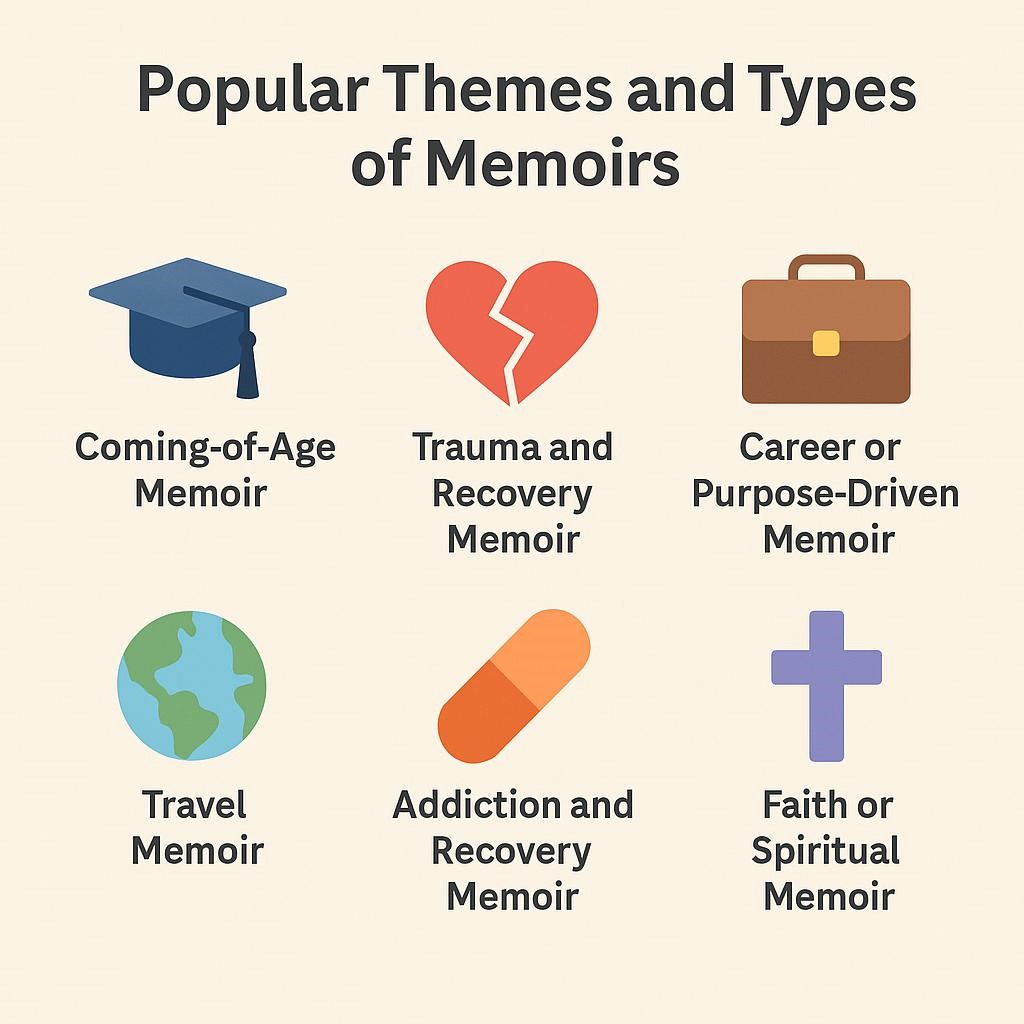
Common Memoir Themes
Some memoir themes return again and again. Not because they’re repetitive, but because they’re universal. They speak to what it means to be human.
- Identity and belonging: Who am I, and where do I fit?
- Mental health: Breaking the silence around anxiety, depression or trauma.
- Family dynamics: Conflict, reconciliation, estrangement, healing.
- Addiction and recovery: The journey through darkness toward something lighter.
- Grief and loss: Living after the unthinkable.
- Courage and survival: Rising when it would have been easier to stay down.
Whatever your story, it likely touches on more than one of these. You don’t have to choose just one theme. But knowing what your core message is will shape how you tell it.
Finding Your Fit
You don’t have to fit neatly into one type. Your story might blend a spiritual journey with family healing. Or a career memoir with mental health reflections. The beauty of memoir is that it doesn’t have to be tidy. It just has to be true.
If you’re not sure what kind of story you’re telling, reading other memoirs is a powerful place to start. Look at how they’re structured. What they focus on. What they leave out. You’ll start to recognize patterns in what moves you and what kind of story you might be meant to write.
And if you need guidance in shaping your narrative, there are memoir writing services that can help you clarify your direction and bring structure to your memories.
Step-by-Step Guide to Writing a Memoir
So you’ve decided to write a memoir. Maybe you’ve already scribbled a few scenes, or maybe you’ve just been carrying the idea around, unsure of where or how to begin. The truth is, memoir writing can feel like walking into a forest without a map. You know there’s something beautiful in there. You just need a path to follow.
This is where structure becomes your friend. Below is a step-by-step guide to help you move from scattered memories to a story that feels whole and purposeful. One that’s honest, engaging and uniquely yours.
Step 1: Find Your Frame
You don’t need to tell your entire life story. In fact, you shouldn’t. Memoir is not autobiography. It’s a focused lens on a part of your life that changed you.
Start by asking yourself: What is this really about? Is it a story of healing? A journey of identity? A season of love, loss or transformation?
Once you find the emotional core, you can begin to shape your story around it. That might mean choosing a specific time period, a recurring relationship, or a key life event that ties it all together. If you’re unsure how to write a memoir outline, begin with the change. What changed in you or around you? Then build around that.
This becomes the spine of your story. Everything else hangs from it.
Step 2: Craft the Story Through Scenes
Memoir works best when it reads like a novel. That doesn’t mean you make things up. It means you bring the reader into your world with vivid, sensory scenes.
Don’t just tell us what happened. Show us. Let us feel the rain on your coat, hear the clink of your mother’s wedding ring on a teacup, see the tremble in your hands as you dial the phone.
Use dialogue, setting and action to bring moments to life. Stay close to your narrator’s emotional truth. That honesty will carry more weight than perfect prose.
Also, pay attention to pacing. Too much reflection without action, and your reader may drift. Too much action without reflection, and the story loses depth. Find the rhythm between the two.
Step 3: Build a Writing Habit
Writing a memoir doesn’t happen in a weekend. It’s a long, emotional process. It’s also one of the most rewarding things you can do.
Create a routine that respects your energy and your boundaries. Whether it’s fifteen minutes each morning or two hours every Saturday, consistency matters more than intensity.
Use writing prompts to jog forgotten memories. Write first, edit later. Let it be messy. That’s how the truth gets out. You can shape it later.
And don’t be afraid to take breaks when it gets heavy. Writing about real life requires care.
Step 4: Learn from Other Memoirs
Every great memoirist started out unsure. Reading their work can help you find courage and direction.
Read widely within the genre. Take note of how they begin, how they end, and how they transition through the middle. What made you care? What stayed with you?
Some memoirs use traditional storytelling. Others blend reflection, letters, essays or even journal entries. There’s no one right way. There’s only what feels true to the story you’re telling.
If you’re still wondering how to start a memoir, go back to a moment you can still feel in your body. A conversation. A goodbye. A silence. That can be your first scene.
Step 5: Edit and Refine
Once you’ve written a draft, step back. Look at the shape of your story. Does it arc toward something? Does it return to the emotional core you started with?
Trim what doesn’t serve the theme. Expand the scenes that carry emotional weight. Make sure your narrative voice stays consistent.
Don’t rush this part. You may go through several revisions before it feels right. Get feedback from people you trust. If possible, work with a developmental editor who understands memoir. Their outside perspective can help you see what’s missing or unclear.
Step 6: Prepare to Share It
At some point, you’ll feel ready to share your story. Whether that’s through traditional publishing, or wanting to opt for self-publishing services or simply giving it to your family, the act of finishing is powerful.
You don’t need to be famous or have a big platform. You just need to be honest. Readers connect with truth.
And if you want help polishing or shaping your manuscript, consider working with professional memoir writing services. They can guide you through structure, tone, pacing and even the publishing process.
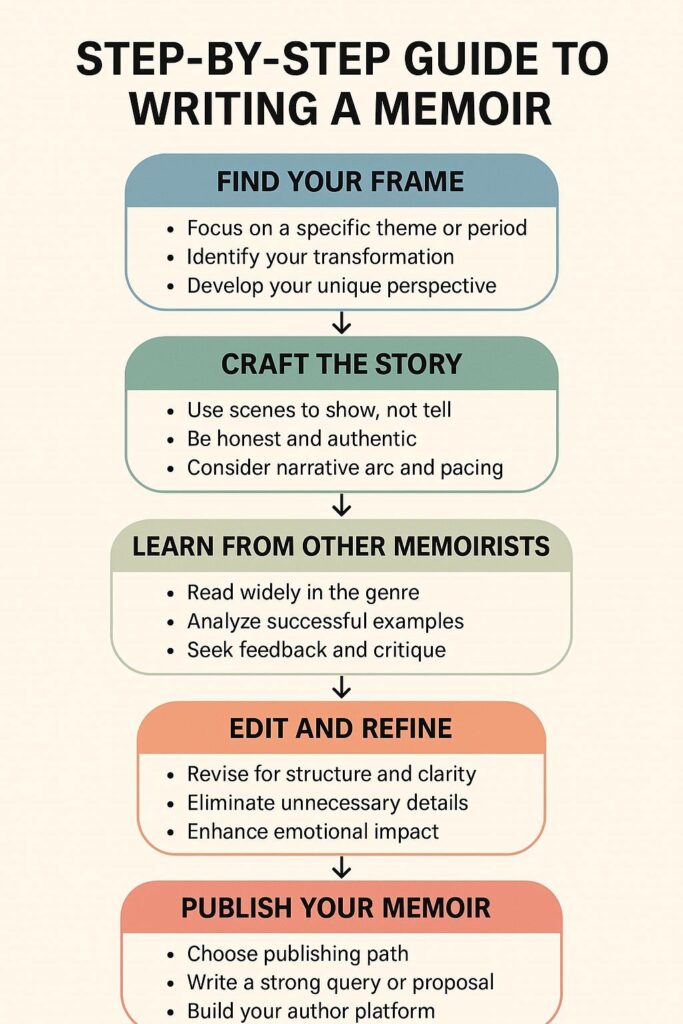
FAQs
1. What’s the difference between a memoir and an autobiography?
A memoir focuses on a specific slice or theme from your life. It’s about how events affected you emotionally or changed your perspective. An autobiography covers your whole life from birth to the present, often told in chronological order and with more emphasis on factual details. Memoirs are more personal and reflective, while autobiographies are broader and more historical in nature.
If you want to reflect on one transformative experience, such as grief, recovery, or identity, a memoir is likely the better fit.
2. Can I change names or events to protect privacy in my memoir?
Yes, you can. It’s common to change names, identifying details, and sometimes even blend or compress events to protect others’ privacy, especially when dealing with sensitive topics. That said, you should still aim to tell the emotional truth of what happened. If you’re planning to publish traditionally, it’s wise to include a disclaimer and consult a legal expert if your story involves potentially defamatory content.
3. Do I need to tell the whole truth in my memoir?
This depends on what you mean by “truth.” Memoir doesn’t require perfect recall of dates or dialogue. It asks for emotional honesty. What did it feel like to be there? How did the moment shape you?
Some memories are hazy, and that’s okay. If you’re unsure about a detail, it’s better to admit it in the text or leave it out than to fabricate. Readers will forgive gaps. What they won’t forgive is manipulation or dishonesty.
4. What’s the ideal length for a memoir?
Most memoirs range from 60,000 to 90,000 words. That’s about 200 to 300 pages. If you’re self-publishing or writing primarily for family, you have more flexibility. But for traditional publishing, keeping it within that range improves your chances of getting picked up.
Rather than aiming for a word count, focus on whether your story feels complete. Have you given it enough room to breathe? Have you said what needed to be said?
5. Should I outline my memoir or discover it as I go?
Both approaches work, depending on your style. Some writers prefer to dive in and find the story along the way. Others need structure from the start. If you’re feeling overwhelmed, learning how to write a memoir outline can bring clarity and direction. Start by identifying your core theme, then list key scenes that support it.
Outlining doesn’t mean locking yourself in. It just gives you a path to follow, and you can always stray from it when needed.
6. How do I know where to begin my memoir?
This is one of the most common hurdles. If you’re unsure how to start a memoir, begin with a vivid moment that still lives in your memory. A conversation you can’t forget. A turning point. A goodbye. It doesn’t have to be your earliest memory, just one that carries emotional weight.
Often, that first scene becomes a doorway into the rest of your story. It doesn’t need to be perfect. Just honest.
7. Do I need a writing coach or editor for my memoir?
Not necessarily, but it can make a big difference. A coach can help you stay motivated, while an editor can ensure your structure, pacing and voice are working together. If you’re writing something deeply personal, an outside perspective can also help you see what readers might not understand or where you’ve left gaps.
That said, many people write powerful memoirs on their own. The key is to keep refining and get feedback at some point in the process.
8. What if my story feels too ordinary for a memoir?
It’s easy to think no one will care, especially if your life doesn’t seem “big” or dramatic. But some of the most powerful memoirs are about everyday moments; grief, identity, family tension, personal growth. What matters is not the size of the event but the depth of insight.
Choosing relatable memoir themes like resilience, self-discovery or forgiveness can make even quiet stories resonate deeply. What readers want most is honesty. If you can give them that, your story will matter.
Conclusion
Writing a memoir is not just about telling your story. It’s about finding the courage to sit with your past, make sense of it, and shape it into something honest and whole. It’s about choosing one moment, one thread, and following it, even when it’s hard.
The process will challenge you. Some days the words will come easily, and some days they won’t. That’s okay. Memoir isn’t about perfection. It’s about truth.
You don’t need anyone’s permission to begin. You don’t need a writing degree, a publishing deal, or a dramatic life. All you need is the willingness to tell the truth as you lived it.
If you’ve made it this far, something inside you is ready.
So now you know how to write a memoir. The only thing left is to begin.
Start with one scene.
One memory.
One paragraph. And trust that the rest will follow.

